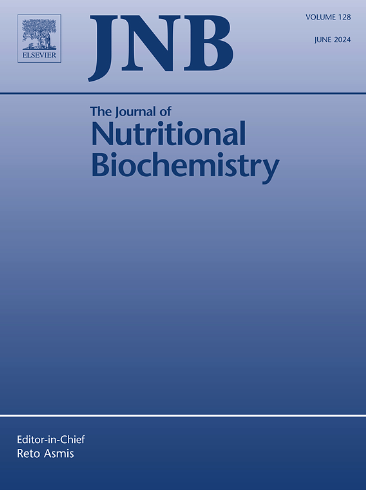Protective effects of Kaempferol on hepatic apoptosis via miR-26a-5p enhancement and regulation of TLR4/NF-κB and PKCδ in a rat model of nonalcoholic fatty liver
IF 4.8
2区 医学
Q1 BIOCHEMISTRY & MOLECULAR BIOLOGY
引用次数: 0
Abstract
This study aimed to evaluate kaempferol's, a dietary flavonoid widely present in plants, potential impact on nonalcoholic fatty liver disease (NAFLD) and its underlying mechanisms. In this study, 60 adult male rats were used and divided into a control group receiving a standard pellet diet, a kaempferol-treated group receiving kaempferol (250 mg/kg), a high-fat diet (HFD) group receiving HFD, and a kaempferol-treated HFD group. At the end of the experiment, the total lipid profile and liver enzymes were assayed in the serum. Additionally, oxidative stress (malondialdehyde and superoxide dismutase), inflammatory (tumor necrosis factor-alpha), apoptotic (caspase 3) markers, and nuclear factor-κB (NF-κB) and Toll-like receptor 4 (TLR4) concentrations were assayed in the liver tissues. Furthermore, miR-26a and PKCδ gene expression and beclin 1 immunohistochemical expression were determined in liver tissues. Our findings revealed that kaempferol significantly protects against the development of NAFLD in rats as well as inflammatory, oxidative, and apoptotic changes in their liver tissues by inhibiting PKCδ and the TLR-4/NF-κB signaling pathway while enhancing autophagy (Beclin 1 expression) via upregulating miR-26a expression. Accordingly, kaempferol holds promise as a complementary medication for the prevention of NAFLD. Nonetheless, more research is needed to fully understand its additional effects on liver tissue and to develop novel medications that activate miR-26a.
A link between lipid metabolic abnormalities and miRNAs was demonstrated as upregulating miR-26a-5p by kaempferol mitigates the inflammation, apoptosis, and disrupted autophagy via regulating TLR4/NF-κB pathway and PKC in NAFLD.
山奈酚通过增强miR-26a-5p和调节TLR4/NF-κB和PKCδ对非酒精性脂肪肝大鼠肝细胞凋亡的保护作用
本研究旨在评估山奈酚(一种广泛存在于植物中的膳食类黄酮)对非酒精性脂肪性肝病(NAFLD)的潜在影响及其潜在机制。本研究选用成年雄性大鼠60只,分为标准颗粒饮食对照组、山奈酚处理组(山奈酚250 mg/kg)、高脂饮食组(HFD)和山奈酚处理HFD组。实验结束时,测定血清总脂质谱和肝酶。此外,检测肝组织中氧化应激(丙二醛和超氧化物歧化酶)、炎症(肿瘤坏死因子- α)、凋亡(caspase 3)标志物、核因子-κB (NF-κB)和toll样受体4 (TLR4)浓度。进一步检测miR-26a、PKCδ基因表达及beclin 1免疫组化表达在肝组织中的表达。我们的研究结果表明,山奈酚通过抑制PKCδ和TLR-4/NF-κB信号通路,同时通过上调miR-26a表达增强自噬(Beclin 1表达),显著保护大鼠NAFLD的发展以及肝组织的炎症、氧化和凋亡变化。因此,山奈酚有望成为预防NAFLD的补充药物。然而,需要更多的研究来充分了解其对肝组织的额外影响,并开发激活miR-26a的新型药物。新的和值得关注的是:山奈酚上调miR-26a-5p通过调节TLR4/NF-κB通路和PKC减轻NAFLD的炎症、凋亡和自噬中断,证明了脂质代谢异常与miRNAs之间的联系。
本文章由计算机程序翻译,如有差异,请以英文原文为准。
求助全文
约1分钟内获得全文
求助全文
来源期刊

Journal of Nutritional Biochemistry
医学-生化与分子生物学
CiteScore
9.50
自引率
3.60%
发文量
237
审稿时长
68 days
期刊介绍:
Devoted to advancements in nutritional sciences, The Journal of Nutritional Biochemistry presents experimental nutrition research as it relates to: biochemistry, molecular biology, toxicology, or physiology.
Rigorous reviews by an international editorial board of distinguished scientists ensure publication of the most current and key research being conducted in nutrition at the cellular, animal and human level. In addition to its monthly features of critical reviews and research articles, The Journal of Nutritional Biochemistry also periodically publishes emerging issues, experimental methods, and other types of articles.
 求助内容:
求助内容: 应助结果提醒方式:
应助结果提醒方式:


